Affiliate disclosure: This post may contain affiliate links. Please see our Privacy Policy.
Coral Mushrooms (Ramaria species and Artomyces Species) have been largely overlooked by the foraging community in the Western world, but they’re commonly eaten in many countries. Many species have turned out to be not only edible but delicious. There are, however, still toxic species of coral mushrooms, so these mushrooms are not for beginners!
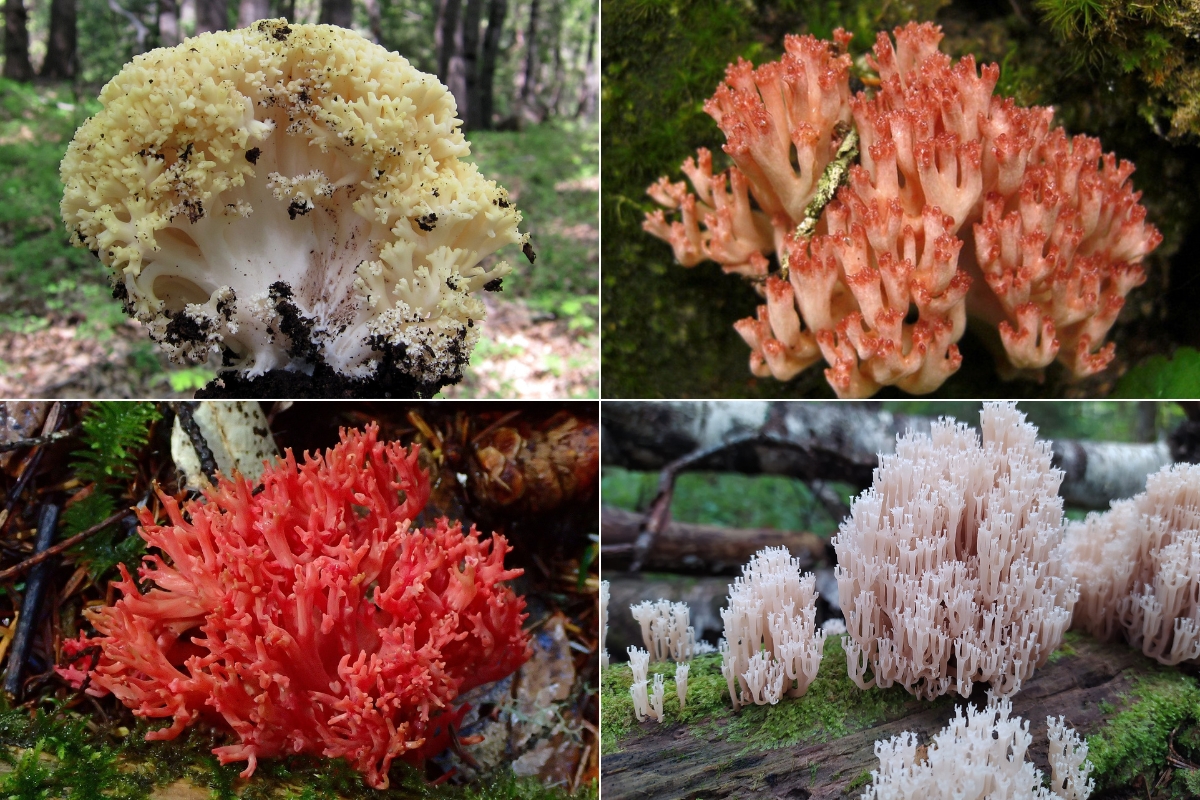
This article was written by Timo Mendez, a freelance writer and amateur mycologist who has foraged wild mushrooms all over the world.
Coral Mushrooms defy everything you’ve come to expect from a typical mushroom. They have no caps, no stems, or any of the other features you would come to expect from a mushroom. Instead, they make intricate branching structures more reminiscent of an underwater landscape than anything we see on land.
Despite seeming unusual, this coral-like form is not uncommon in the world of fungi. They contain many diverse lineages, comprising hundreds of different species, that fall under the category of coral mushrooms. Some Coral Mushrooms are more related to single-celled yeasts than to other varieties of Coral Mushrooms!
While many foragers in the United States and Europe often disregard the edibility of coral mushrooms and even consider them toxic, around the world, many different coral mushrooms are foraged as prized edibles. In México, China, and other parts of the world, Coral Mushrooms are even widely commercialized and sold in markets.
Meanwhile, euro-centric mushroom culture doesn’t value them in the same way as other wild mushrooms. No one thinks twice about them, and you’ll probably never see them in a market. It’s not exactly clear why, but there seems to be a legacy of caution and aversion when it comes to coral mushrooms. Many perfectly edible species are even listed as toxic in field guides, and fearful lore around the uncomfortable “laxative” effects of certain species turns off even experienced foragers. Which, just to mention, is a potential side effect of certain species.
Despite this apprehension, there indeed seems to be a growing interest in them amongst the greater mushroom-foraging community. While I don’t remember anybody foraging these when I first got into mushrooms almost 10 years ago, it seems that many people, including many well-known mushroom influencers, have broken the veil of superstition and begun to harvest them for the table. The famous mycologist David Arora, who is famous for breaking Western fungiphobic taboos, played a particularly important role in demystifying their edibility in the United States.
I can attest that for the longest time, I too disregarded corals as edible species. I was told it’s not exactly clear how to differentiate the edible species from the ones that make you run to the bathroom. I was told you had to look at the spores under a microscope and take a detailed look at a dichotomous key before you dared prepare one for dinner. Not to mention, there are likely many undescribed species. I wasn’t ready for that.
Thankfully, while it can be exceptionally hard to determine an exact species, classifying them into genera and determining if a species is edible is much simpler.
My first time-consuming Coral Mushrooms was after finding them in a market near my family home in Mexico City. My favorite mushroom vendor, who came from the neighboring state of Morelos, brought a tall stack of milk crates filled to the brim with a rainbow-colored assortment of Coral Mushrooms in the genus Ramaria. I eagerly purchased some and took them back home to cook them up for lunch. I fried them up with onion, salsa, and a small branch of epazote (an aromatic herb that almost always accompanies wild mushrooms in Mexican recipes). They were freaking amazing. While the flavor is mild, the texture is one of my favorites.
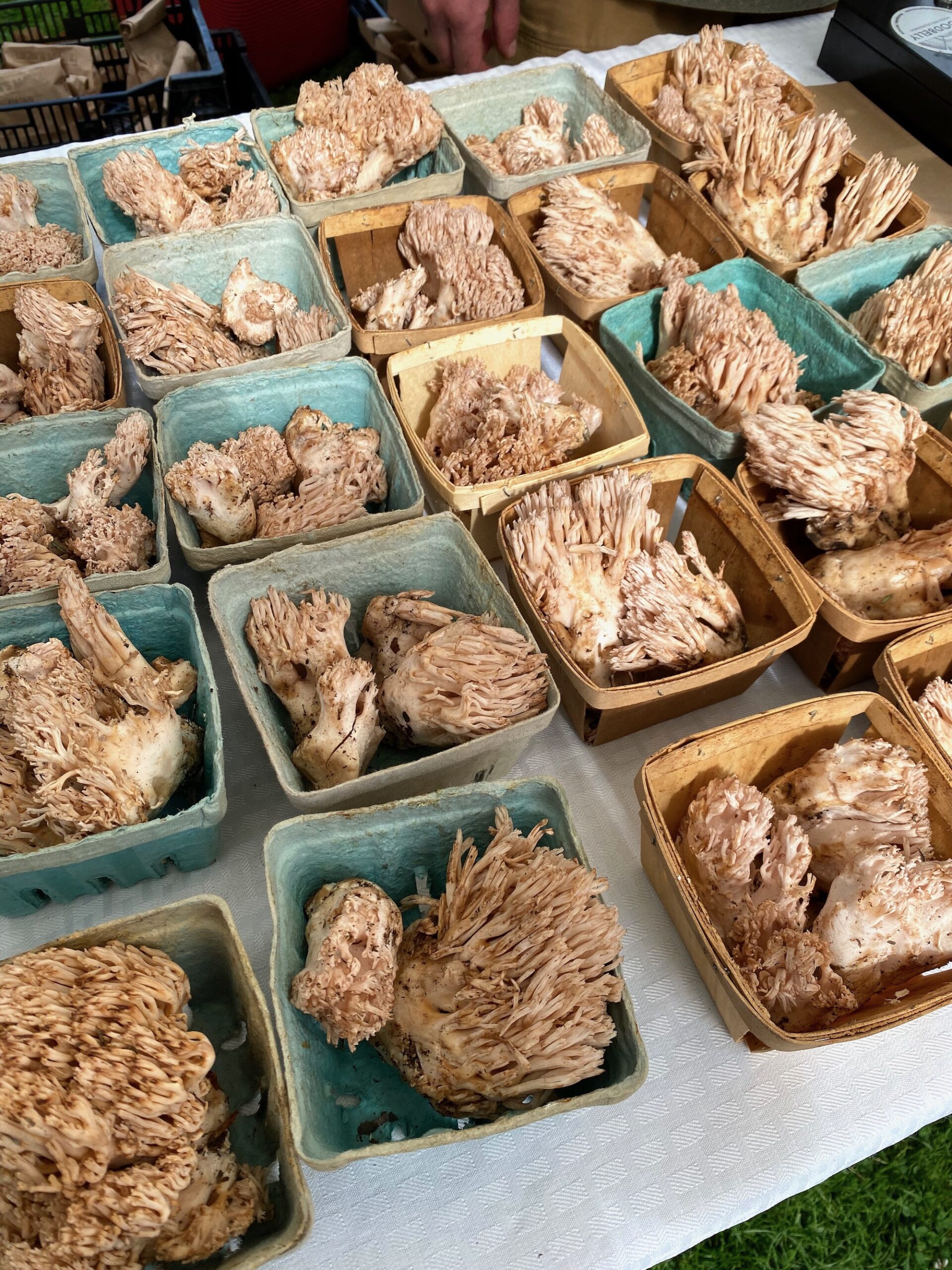
Ramaria botrytis”
What is a Coral Mushroom?
Before moving forward, I want to clarify that the term “Coral Mushrooms” is an informal group of coral-shaped fungi that includes hundreds of species. This coral form was evolved independently by various lineages of fungi, some of which are worlds apart from a genetic standpoint. They have different ecologies, habitats, forms, colors, flavors, and, of course, levels of edibility. Thankfully, there are distinct differences between every group, and some simple rules can help you identify them.
This being said, ALWAYS use discretion. Corals are not an easy group of mushrooms, and I don’t recommend them for beginners. This is especially true if they’re something you and your community aren’t familiar with. Do your research (beyond this article) and consult a local expert if you have any doubts.
Most North American foraged coral fungi are associated with GI upset risk rather than life-threatening toxins. While this could just be mild discomfort, for people with sensitivity or existing health conditions, it could be more serious.
If it’s your first time trying a certain variety, only eat a small amount, at least to begin with. Even those with the strongest stomachs occasionally have bad reactions to certain species of fungi (I can’t for the life of me digest Chicken of the Woods, for example), and this can definitely happen if consuming large portions. From what I’ve heard, the purgative effects of certain coral mushrooms are very unpleasant and will start within just a couple of hours after consumption.
Different Types Of Corals
The term “Coral Mushroom” is colloquially used to describe hundreds of different species from vastly different genetic lineages of fungi. While many are only distantly related, what they have in common is the branched coral-like structure that is rather distinct compared to most other mushrooms.
Some are thick and fleshy, while others are thin and rather fragile. Many are white or dull-yellow in color, but some have eye-catching yellow, pink, and purple colors. Most species grow directly from the ground, but a few pop up from rotting woody debris.
Two of the most common types of Coral Mushrooms that are regularly foraged are those in the genus Ramaria and Artomyces. While there are other edible species in other genera, I am not as familiar with them, and they’re not consumed as frequently in the greater mushrooming community. I will discuss some of the other coral mushrooms in the lookalike section.
Ramaria
Ramaria is a group that contains hundreds of different species of coral mushrooms. These are generally the largest and most fleshy of all the coral mushrooms. They come in a magnificent assortment of colors and occur ubiquitously in temperate forests, both hardwood and coniferous. These species are typically considered mycorrhizal, although certain species may be decomposers. They can be found almost any time of year when moisture is abundant.
The main identification features for Ramaria are that they are large, fleshy, and have a big base that is white in color. While this is not necessarily true for all Ramaria species, the ones with the highest culinary value do have a large, fleshy base. They are completely white through the middle and form bifurcating branches, with bifurcation nodes becoming closer together towards the end. When they are really young, certain species may only have small, undeveloped branches coming from their large base. The texture is often gelatinous and rubbery before cooking.
Certain species of Ramaria are bitter, and this is the determining characteristic of edibility. While they may not necessarily be toxic, bitter species are not recommended for consumption. To test bitterness in the field, simply take a small piece of the mushroom, chew it, and place it on your tongue. If it’s bitter, it should only take a couple of seconds before the taste comes through. Afterward, spit it out.
Don’t worry, this is a perfectly safe practice and will not lead to intoxication, even if the species is inedible. Taste tests like this are a common practice in the field of mycology. Some people recommend eating only brightly colored Ramarias. While I’m not sure about the validity of this rule, I tend to stick with it.
So, the general rules to follow for eating Ramaria are as follows:
- Do not eat species or varieties which have bitter flavors
- Only eat Ramaria with large bases
- Stick with brightly colored Ramarias that are red, pink, purple, orange, yellow, etc.
- Eat in moderation and in small quantities. This is especially true if it’s your first time trying a new species.
- Always use discretion! This is a large group of mushrooms that likely contains many undescribed species.
Identification Features of Ramaria Mushrooms
- Large fleshy base with numerous branches growing from it
- Can be pink, red, purple, yellow, or pale white
- Growing directly from the ground and not wood (usually)
- Tightly packed branches forming a dense bushy structure
- Brown to yellow spores
Common Ramaria Species
It must be stated that identifying a mushroom as Ramaria is one thing but identifying it at the species level can be tricky. There are hundreds of species, some of which look very similar in shape, color, and form.
Yellow Coral Mushroom (Ramaria rasilispora)
These are pale yellow and have a dense chunky structure. They have shorter branches that are closer together than other Ramaria species.
These also have a very large white base from which the branches emerge. These are considered good edibles.
Ramaria aurea and Ramaria flava are two other yellow corals that are considered edible.
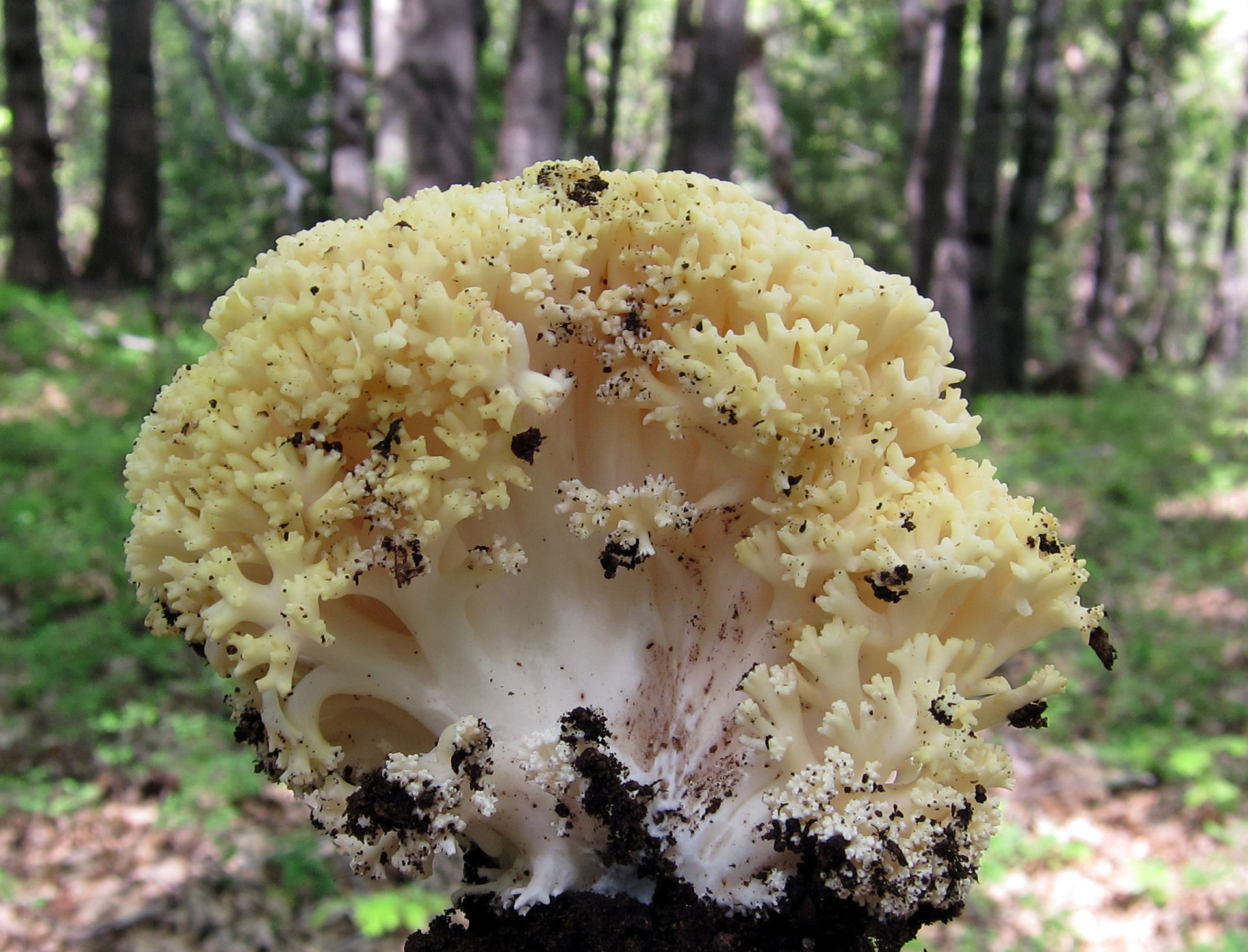
Pink Tipped Coral (Ramaria botrytis)
This elegant species has an amazing purple-to-pink coloring. There may be various species currently using this name, although all tend to have a large base when young.
The branches are small and short together when young and then extend with age. The color also turns paler as it ages. This species is considered edible, and is one of the tastiest corals.
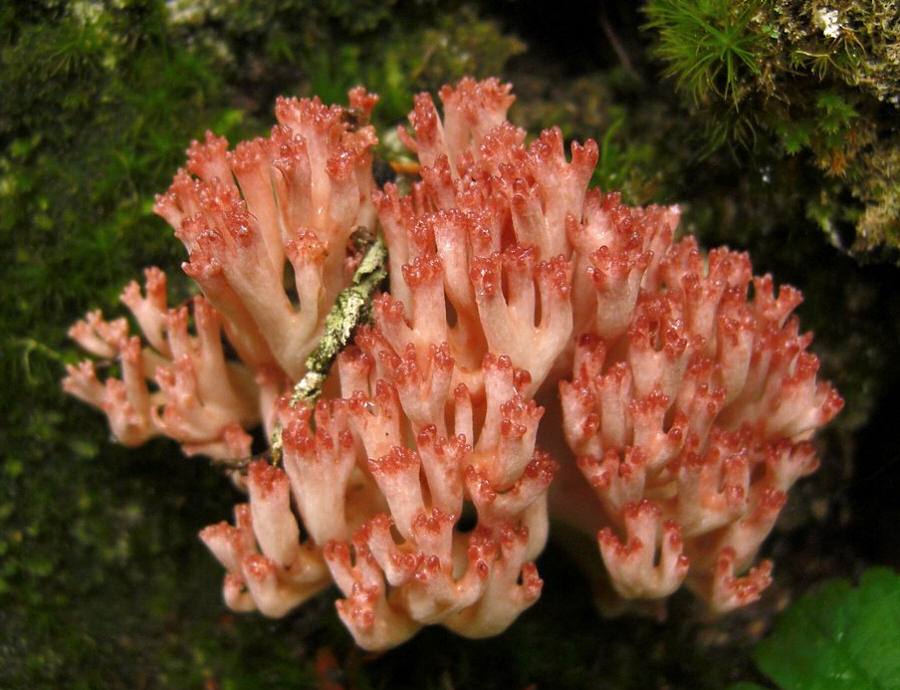
Red Coral (Ramaria araiospora)
This coral has beautiful pink-to-red coloring. It is often found in the Pacific Northwest and fruits in the fall.
This species, or something very similar, can also be found in other parts of the world. It is commonly eaten in Mexico, but there are also reports of GI upset from this species and most mushroom sources list its edibility as unknown.
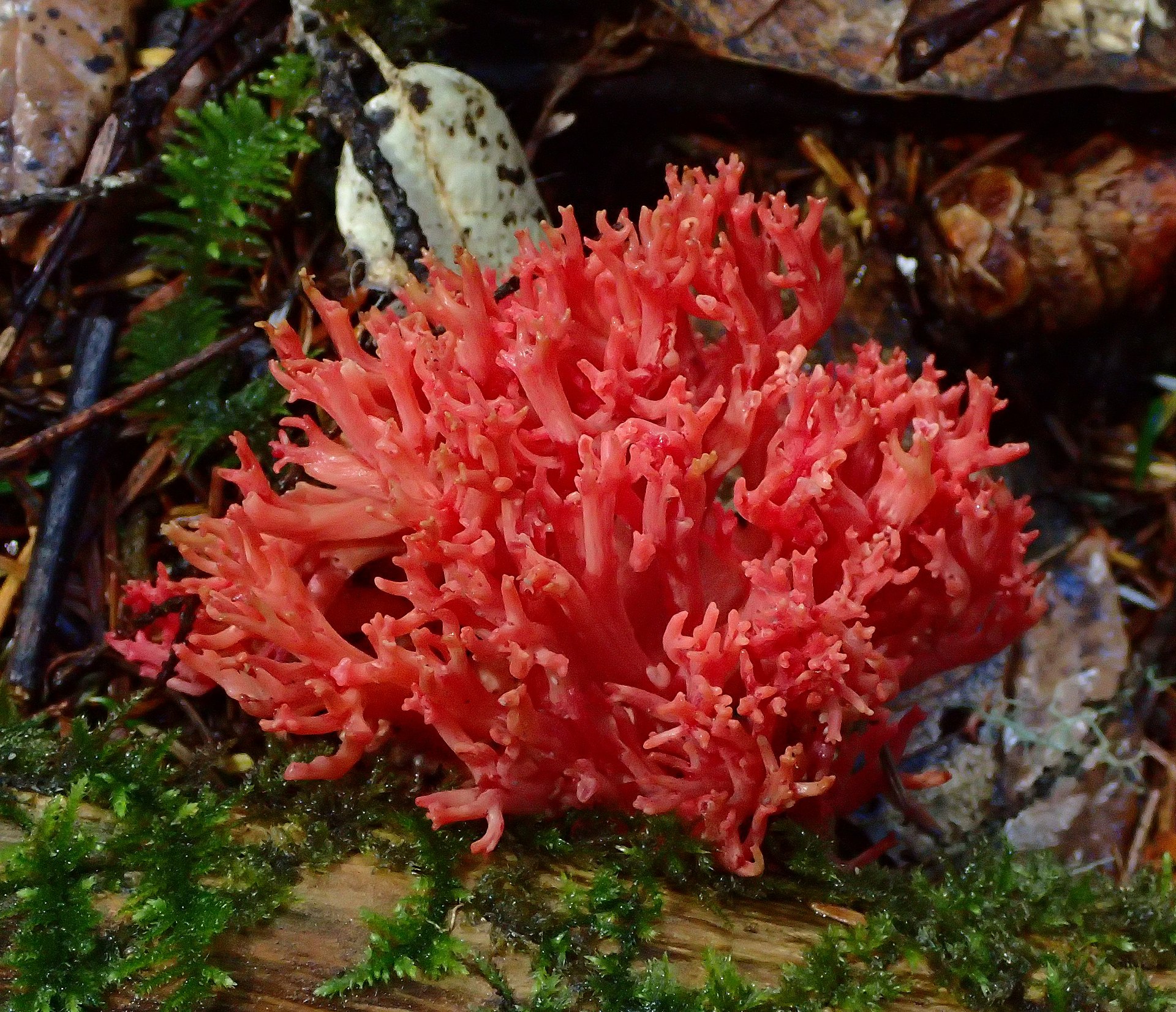
Yellow Tipped Coral (Ramaria formosa)
This is another common species with a yellow-orange coloring that turns pale as it ages. The tips of the branches are slightly darker in color and have a bitter taste.
This species is not considered edible.
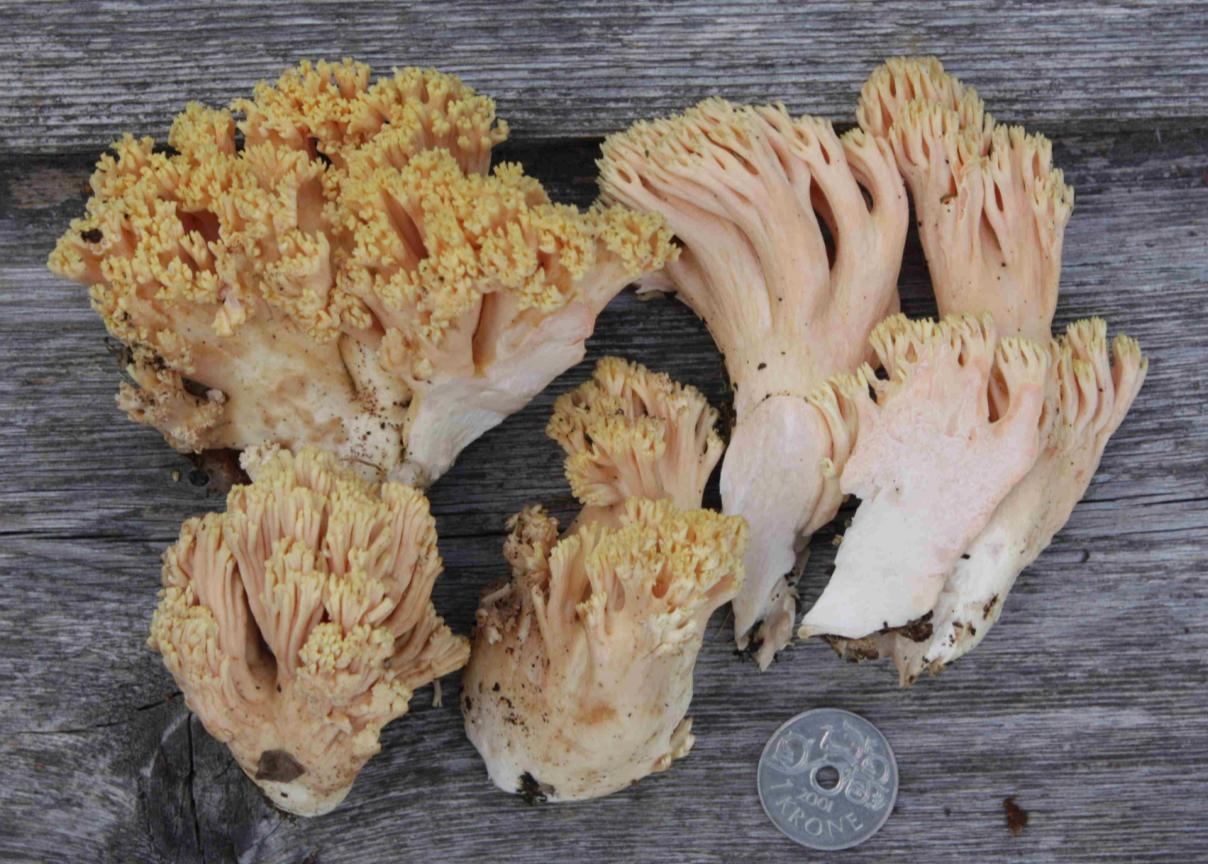
Upright Coral Fungus (Ramaria stricta)
This is one of the easiest species of Ramaria to identify because of its long vertical branching pattern. These are generally a pale-white in color.
This species is not considered edible.
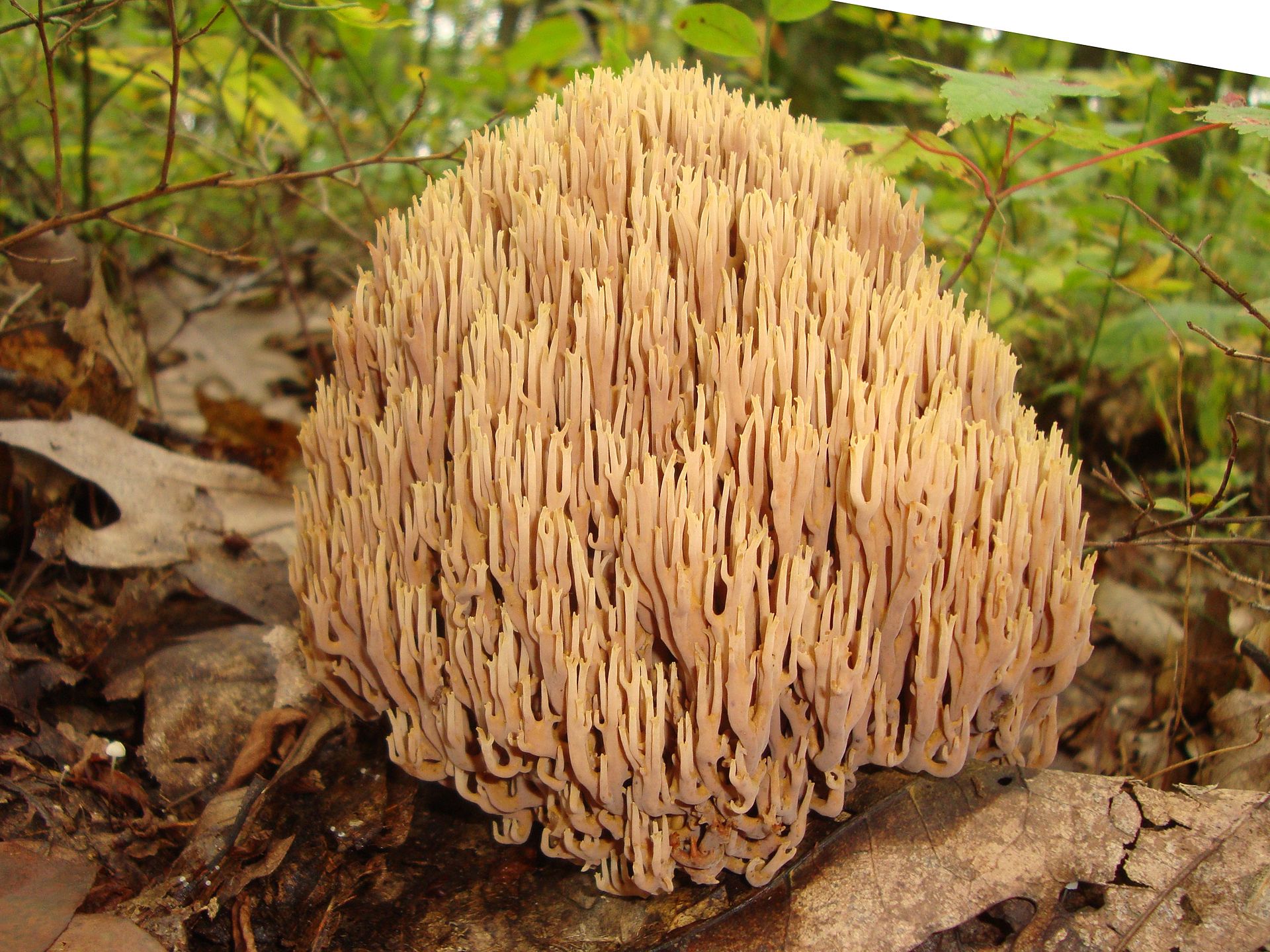
Crown Tipped Coral (Artomyces pyxidatus)
This species, formerly called Clavicorona pyxidata, is found across North America and Europe growing on rotting wood. It is rare or absent on the West Coast, although it does occur in the Rockies.
Its distinctive features are the white-yellow colors and branch tips with a crown-like depression that features about 3-6 points. Plus, unlike other Coral mushrooms, these grow directly from hardwood logs. They have a particular affinity for aspens, tulip trees, maple, and willow. The branches are usually pretty long and grow in an upright vertical position. Unlike Ramaria species, these do not have a large fleshy base from which they grow. They are also generally much more fragile.
Another way to verify this species is with the old taste test. While it’s mild to begin with, this species exhibits a spicy, peppery flavor when raw. This goes away when cooked but serves as a great way to confirm its identity.
Lastly, while this is possibly one of the most commonly foraged Coral Mushrooms in the United States, always consume it in small quantities to begin with just to make sure your digestive system can handle it. This is especially true if you are serving it to people!
Identification Features of Crown-Tipped Coral
- Thin, relatively fragile branches which grow in a strict vertical position.
- Growing from fallen medium to large hardwood logs
- Light-colored spores
- White to pale yellow with age
- Branch tips with a crown-like depression that features about 3-6 points
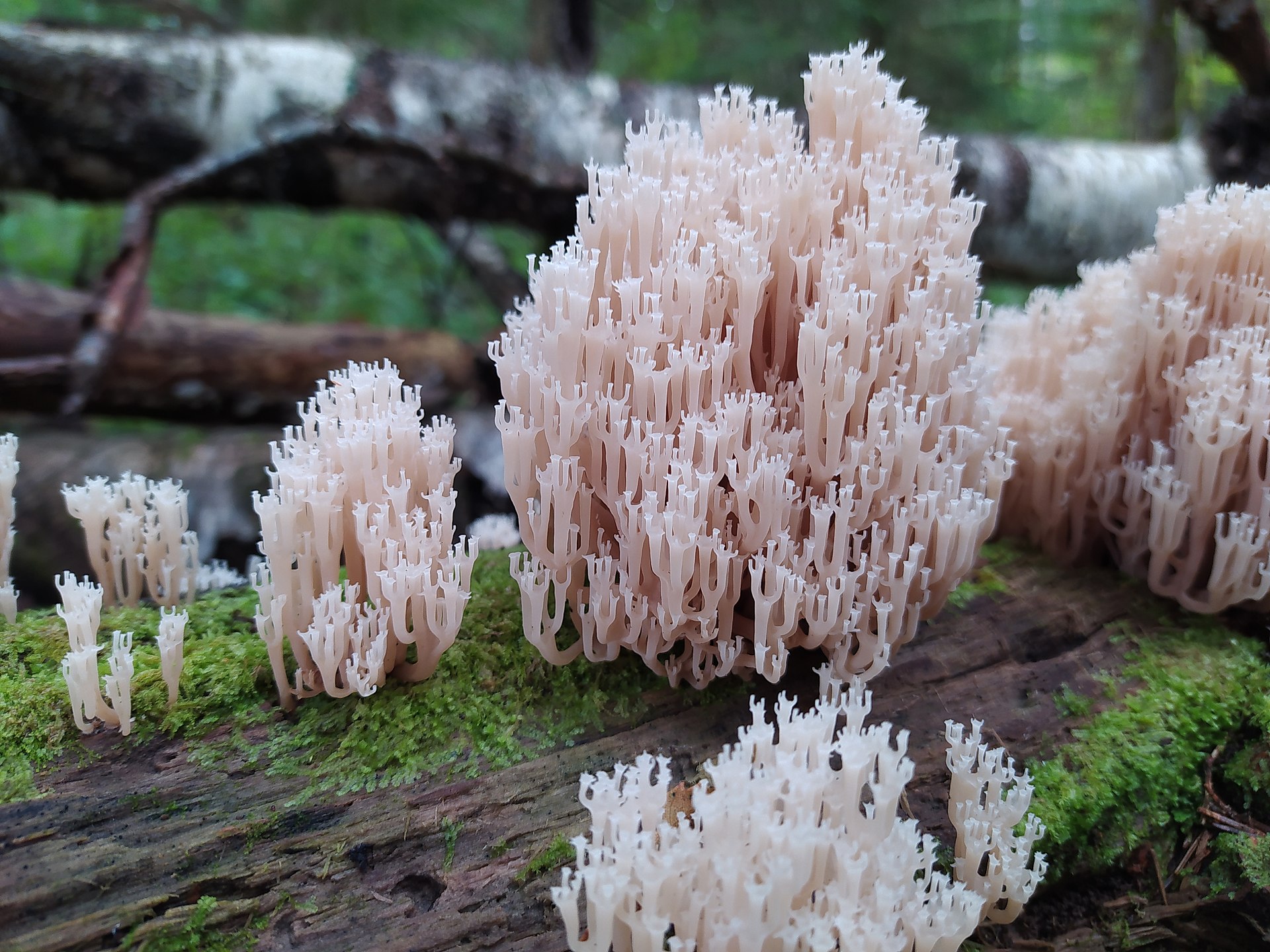
Other Coral Mushrooms and Lookalikes
These mushrooms may not necessarily be toxic, and some genera may actually contain good edibles, but they may be a little less straightforward to identify.
Clavaria
This is a group of fungi consisting of various forms of coral mushrooms. Some species in the genera are considered “club mushrooms” because of their unbranched growth form.
These grow directly from the ground, have white spores, and do not have the large base seen in Ramaria.
These also tend to be less branched and taller than they are wide.
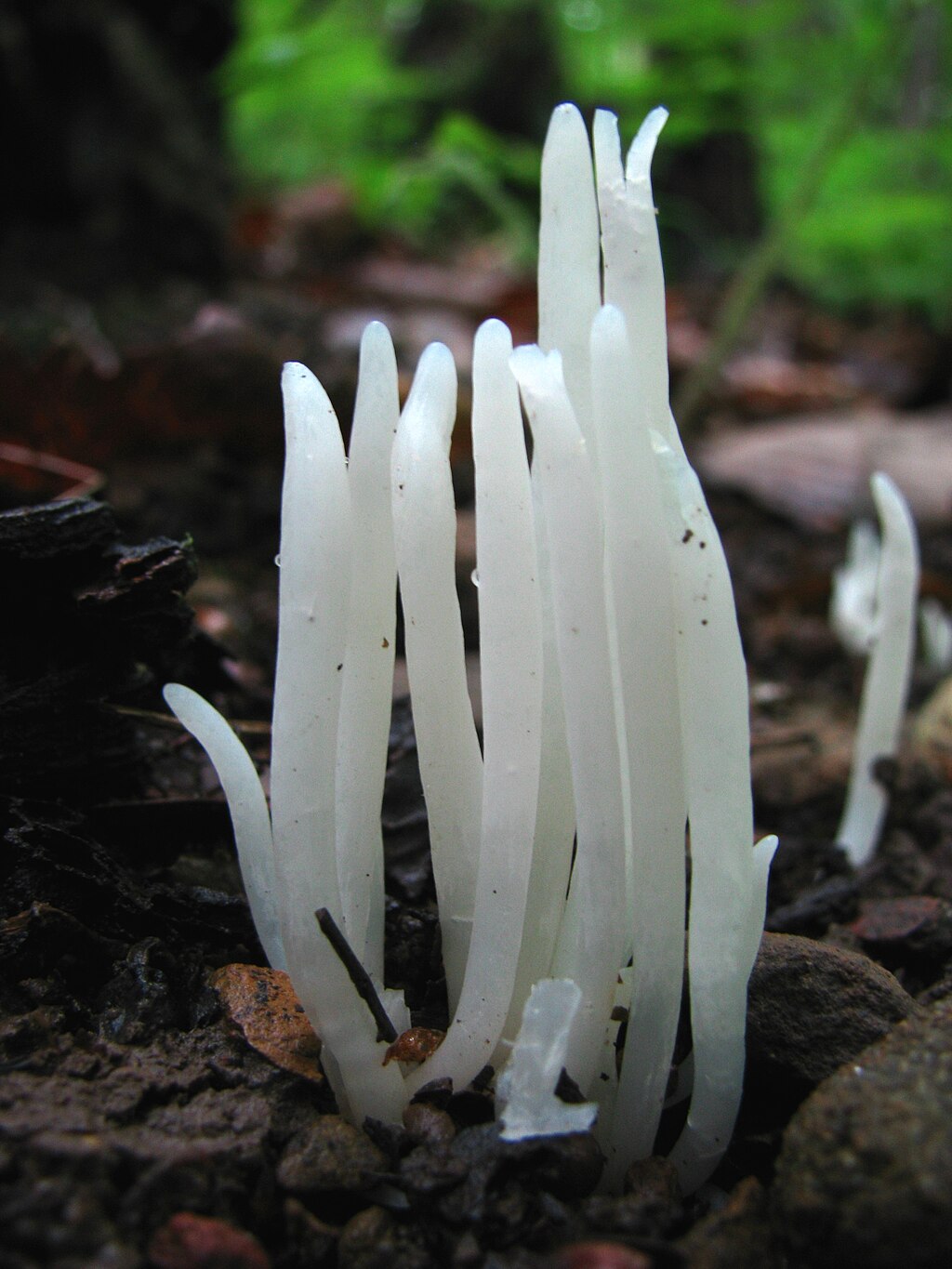
Ramariopsis
Another group of coral mushrooms with diverse colors and growth forms. These tend to grow from a single trunk which bifurcates into branches that grow in a vertical position.
The shape can resemble that of a tree.
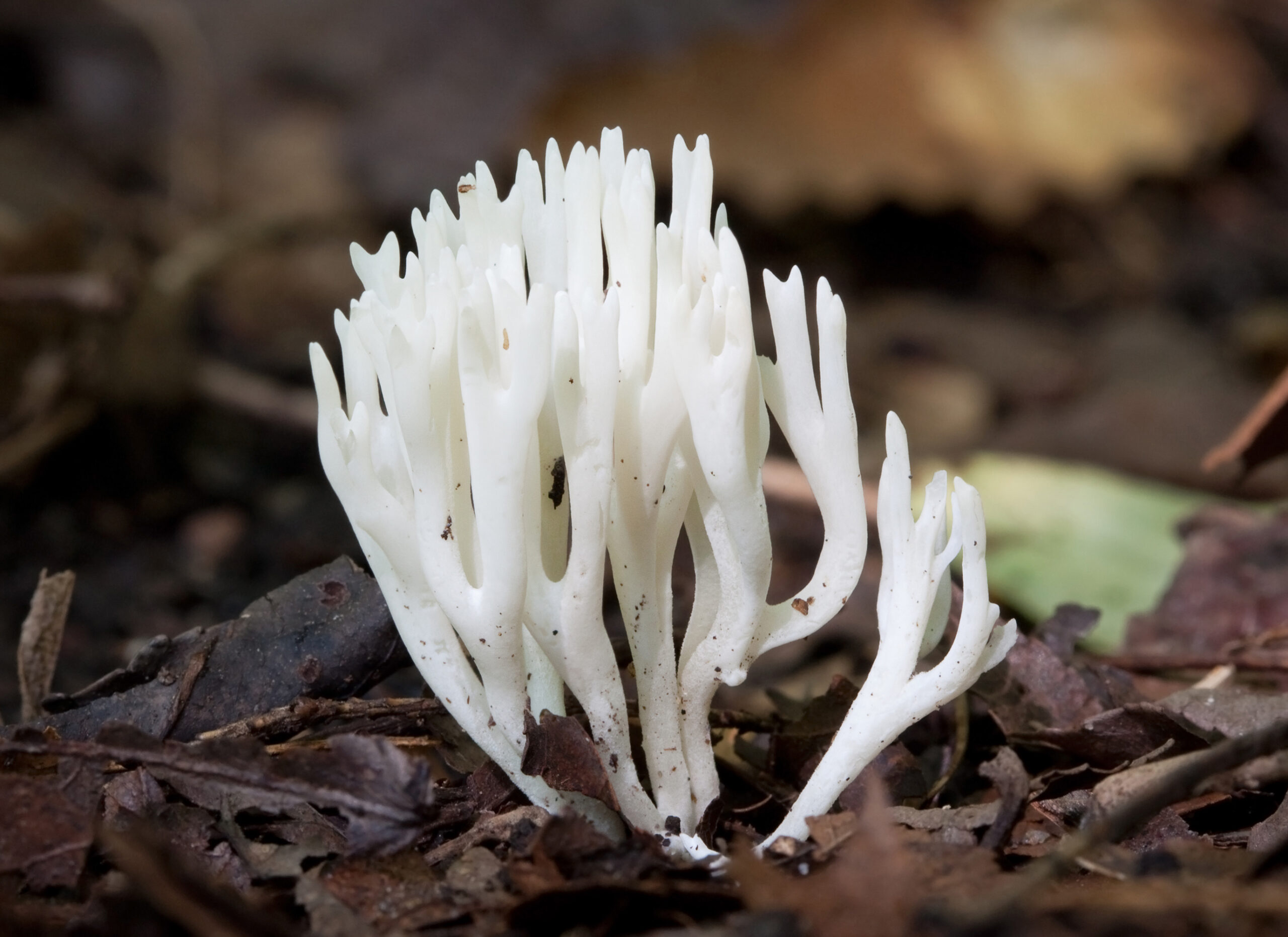
Clavulina
Clavulina species form both coral and club-structured mushrooms. They tend to be white, grey, or dull in color and rarely display the diverse colors seen in other groups.
They may form very long branches with few bifurcations, and like Ramariopsis, grow from a single trunk.

Clavulinopsis
These are mostly club fungi, and many species have yellow, red, and orange colorations.
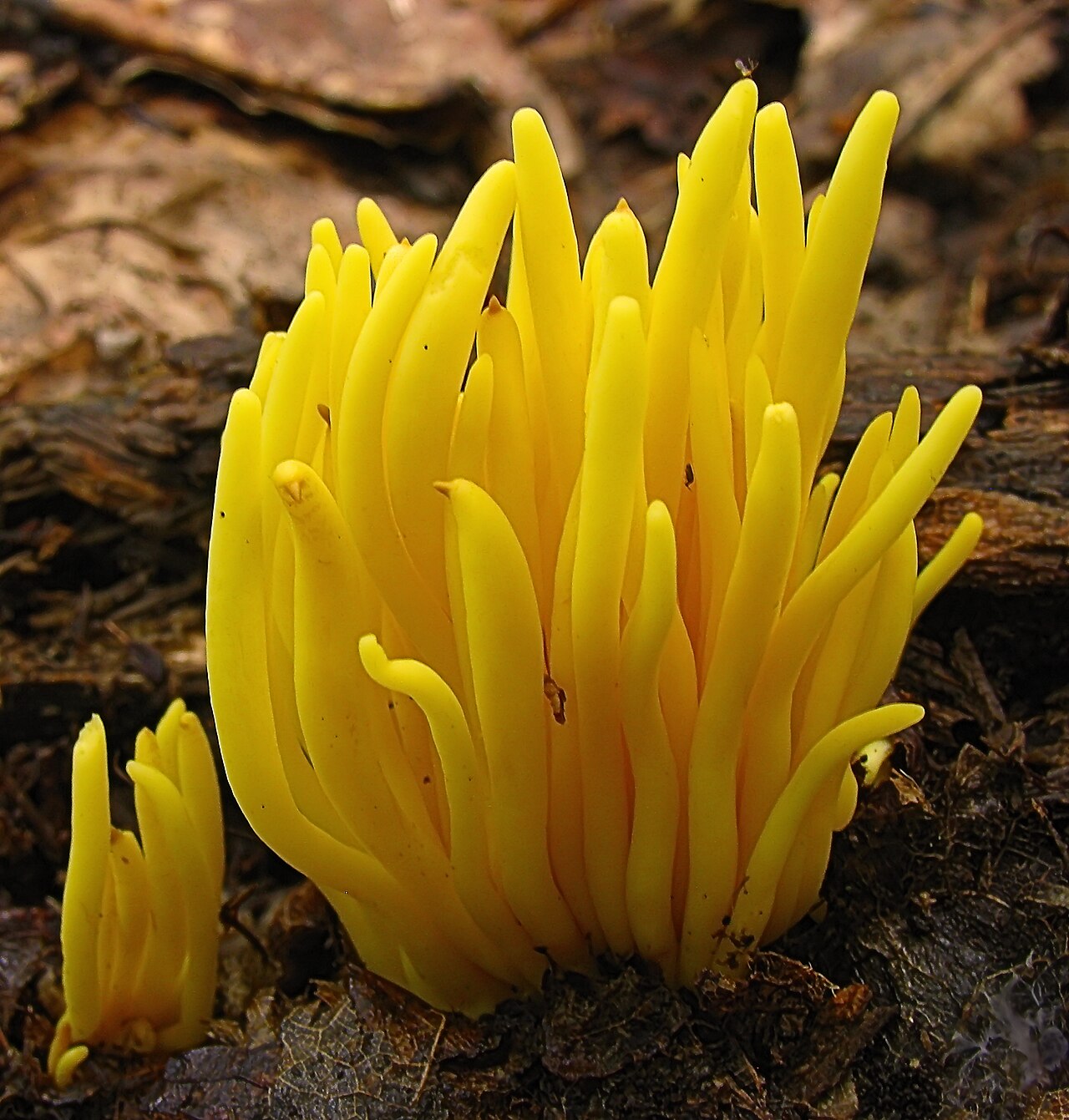
Other genera of Coral forming fungi: Lentaria, Phaeoclavulina, Calocera
How To Harvest Coral Mushrooms
Always forage with respect for the local environment. Don’t litter, cause erosion, or recklessly trample through sensitive environments. Don’t harvest everything; only harvest what you need, and always leave some behind. Respect your local community and promote ethical foraging practices. Oh yeah, if you’re really feeling ambitious, bring an extra bag and bring out any garbage you find on your hunt.
Once you find a nice patch of Corals, take some time to appreciate their presence before harvesting. Take a look at the surroundings and quantify the size of the patch. If you’re not 100% sure of its identification, take many field pictures and only take a small quantity back for further study.
When it comes to harvesting corals, I must say that picking is generally better than cutting. This is especially true with the large, fleshy Ramarias. Once you’ve plucked it, scrape off any dirt-encrusted parts of the mushroom base with a knife and place it in your bag or basket. While I know this might turn some heads, as we’ve discussed in previous articles, there is no real evidence showing that cutting is better than picking. Some evidence suggests plucking may actually improve fruiting body production!
This being said, always respect local customs if you are picking outside of your own neck of the woods. If you do decide to cut, make sure to cut right at the base to avoid having hundreds of individual branches. These are more likely to get damaged or lost during transport.
Once you get back home, keep them in a cool, dry, and well-ventilated area. The fridge might extend the shelf life a little bit, but generally speaking, you should eat them the following day after harvesting. Don’t let your harvest sit around and go to waste.
Cooking With Coral Mushrooms
Every coral mushroom is different and has unique culinary properties. Ramaria is generally fleshy and firm, while crown-tipped corals are more fragile. Even within the genus Ramaria, each species has a different flavor, with some reported to have a sweet flavor. While I haven’t tasted this myself, I’ve heard this from several mushroom-eating enthusiasts.
Personally, I’ll be honest and say that I’ve never really noticed a distinct flavor in coral mushrooms. They do have an earthy flavor, but nothing like the perfumed, nutty flavors of Boletes or Chanterelles. This being said, they have a nice texture and will happily absorb any seasonings or sauces you cook them up with.
You can cook them in any way you imagine. Fried with the old butter and garlic, or put them in stews, stir-fries, or even make them battered and fried. They really do well in soups or saucy dishes. Whatever you do, make sure they are thoroughly cooked to reduce the risk of having an upset stomach. I have heard that in some parts of the world, they are eaten raw, but do this at your own discretion. Generally speaking, I don’t recommend eating raw mushrooms (there are exceptions); cooking makes them easier to digest, and in some cases, heat breaks down potentially toxic compounds.
Preserving Coral Mushrooms
The easiest way to preserve coral mushrooms is the “cook and freeze” method. This will preserve their texture and flavor, plus it makes them easy to incorporate into any meal. I recommend cooking them with a bit of garlic, butter, and onion, or you could simply blanch them in boiling water for 1-2 minutes. Once they’ve cooled down, place them in a container and stick them in the freezer. This way, they can be ready to go for any meal you need them for. Don’t freeze them raw, as this will render them slimy, gooey, and not so pleasant to eat. The only downside to this strategy is that it does require some freezer space.
While I’ve never tried it myself, I’ve heard they’re not too good for dehydrating. They lose a lot of their color, texture, and general appeal.
The other option would be to try pickling them. Simply blanch them for 5-10 minutes in boiling water, then add them to your favorite pickling brine. I haven’t tried it myself, but have heard of others who do it. I can imagine them being nice in a pickle because they don’t have the unpleasant mucilaginous texture of other mushrooms.
Mushroom Foraging Guides
While coral mushrooms may be hard to identify, many of these others are a lot easier!
- Morel Mushrooms
- Chaga Mushrooms
- Birch Polypore
- Tinder Polypore
- Witches Butter Mushrooms
- Puffball Mushrooms
- Shaggy Mane Mushrooms
- Reishi Mushrooms
- Turkey Tail Mushrooms
- Dryad’s Saddle
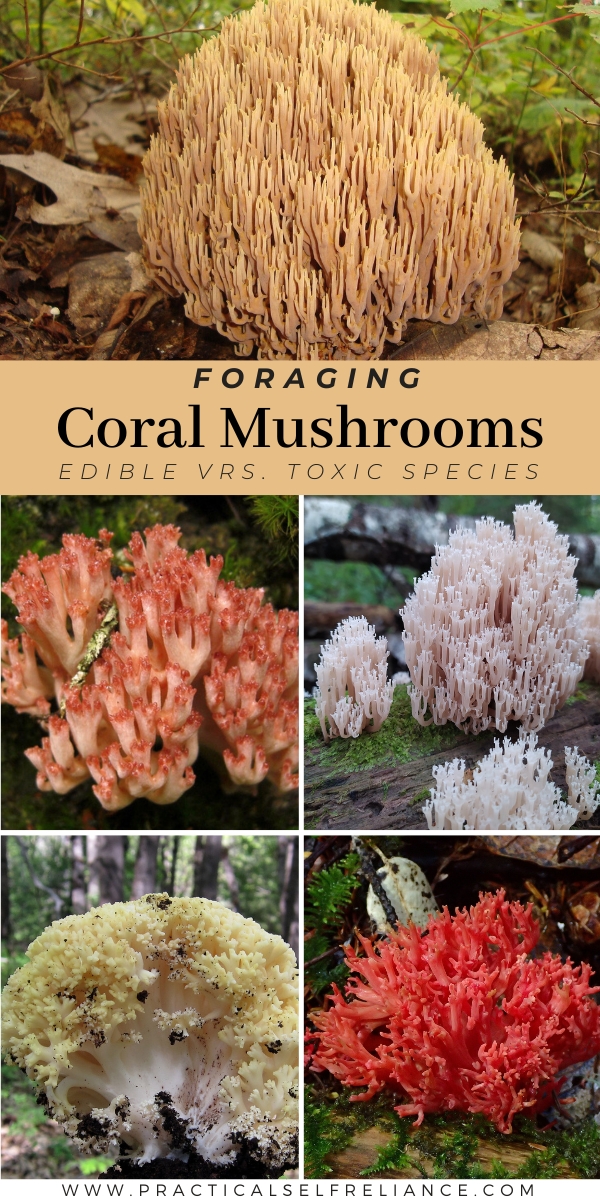

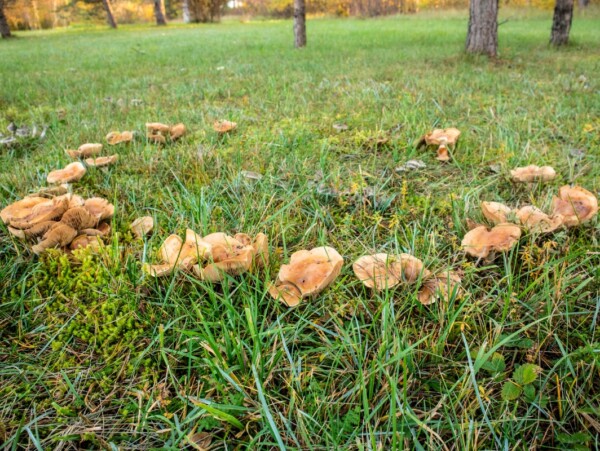
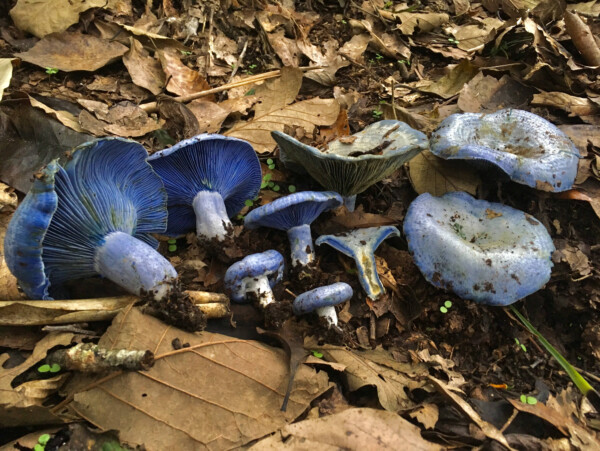
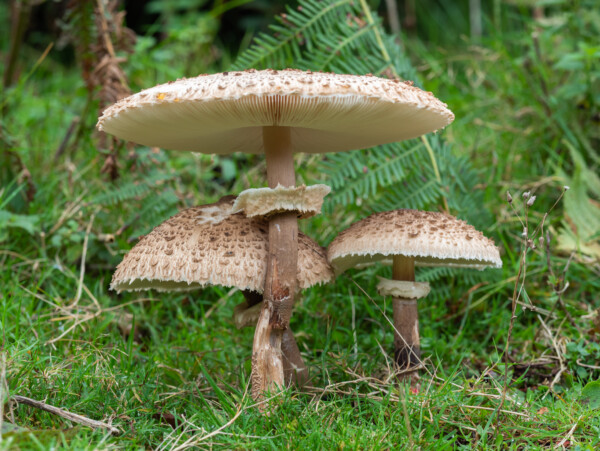










I cant say how true this is, I come across these all the time!
Great write-up, very captivating from start to finish